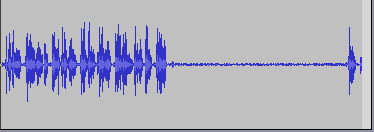Digital voice recorder: raw WMA files

Below are two sample audio files of just over a minute each recorded with an Olympus digital voice recorder. The files are WMA format, exactly as recorded by the Olympus WS-200s. You can hear me operating the controls on the recorder at the start and end of each recording.
Both samples contain 30 seconds of ‘room tone’ or ‘silence’ so you can hear the noise generated by the pre-amplifier circuit in the recorder. The external microphone was a dynamic type with an impedance of about 200 ohms and a highish output (Shure VP64L).
- WS-200S with internal mic in mono HQ mode. The ‘silence’ is about 32 seconds into the recording. The recorder was on a small table with the microphones about 18 inches from my mouth. This is how I imagine these recorders would be used to record a meeting or interview.
- WS-200S with external hand-held mic in mono HQ mode. The ‘silence’ is about 34 seconds into the recording, but one of my neighbours decided to hammer nails into wood outside at around 55 seconds. The microphone was about 6 inches from my mouth and pointing slightly to one side to reduce the sibilants and popping. This is how I’d imagine the microphone might be used for interviews.
When I convert the samples to WAV format and import them into Audacity, I find that the peak recording signal is around -6 to -3 dB for both recordings, and I suppose this shows the action of the automatic gain control. I estimate the noise backgound using the internal microphone to be around -33dB corresponding to a dynamic range of about 30dB. The external mic shows a noise level of roughly -45 dB from the level ‘meter’ in Audacity, again giving a range of about 42dB. As you can hear, recordings with the external mic sound ‘fuller’ and have more mid and low frequency content than the internal microphone recordings. Most of the noise was a ‘rumble’, perhaps due to cable noise or hand holding the mic. I’ll perhaps try a ‘close’ recording with the internal mic later.